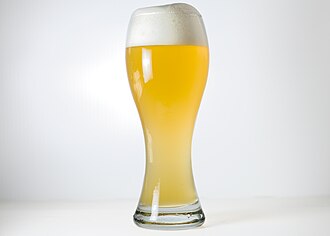Wheat beer
Wheat unfiltered beer is a
Varieties
Weißbier (German – "white beer") uses at least 52% wheat to barley malt to make a light-coloured top-fermenting beer. Witbier (Dutch – "white beer") uses flavorings such as coriander and orange peel. Belgian white beers are often made with raw unmalted wheat.
German Weißbier and Belgian witbier are termed "white beers" because "wheat" has the same
Other wheat beer styles, such as
, are made with a significant proportion of wheat.
Weizenbier

Weizenbier (German:
The Hefeweizen style is particularly noted for its low hop bitterness (about 15
Weißbier is available in a number of other forms, including Dunkelweizen (dark wheat) and Weizenstarkbier (strong wheat beer), commonly referred to as Weizenbock. The dark wheat varieties are made with darker, more highly
The four largest brands in Germany are
British brewers producing cask-conditioned varieties include Oakleaf Eichenblatt Bitte, Hoskins White Dolphin, Fyfe Weiss Squad and Oakham White Dwarf.
Witbier
Witbier, white beer, bière blanche, or simply witte is a barley/wheat, top-fermented beer brewed mainly in Belgium and the Netherlands. It gets its name due to suspended yeast and wheat proteins, which cause the beer to look hazy, or white, when cold. Today, along with hops it usually contains a blend of spices, such as coriander, orange, and bitter orange.
As early as the 16th and 17th century, the white beers of
The style was revived by
Other varieties
A minor variety of wheat beer is represented by
Leipziger Gose is similar to Berliner Weiße, but slightly stronger at around 4% ABV. Its ingredients include coriander and salt, which are unusual for German beers, but are traditional for that style of beer.
Belgian
A variation on the barley wine style involves adding a large quantity of wheat to the mash bill, resulting in what is referred to as wheat wine. This style originated in the United States in the 1980s.[16]
Names and types
Wheat beers vary in name according to where they are brewed and small variations in the recipe. Among those used are:
- Weißbier, short Weiße: Weiß is German for "white". These terms are used almost exclusively in the Southern German state of Bavaria and in Austria.
- Weizenbier, short Weizen: Weizen is German for "wheat". These terms are used in the Western (Baden-Württemberg) and Northern German regions, as well as in Switzerland, for Weißbier.
- Hefeweißbier or Hefeweizen: Hefe is the German word for yeast, is added to indicate that the beer is bottle-conditioned(unfiltered), thus might have sediment.
- Kristallweißbier or Kristallweizen: Kristall, being German for crystal, is added if Weißbier is filtered clear of sediment.
- Dunkles Weißbier or Dunkelweizen: A dark version of a wheat beer (dunkel is the German word for "dark")
- Weizenbock is a wheat beer made in the bock style originating in Germany.
- Witbier (literally, "white beer") or simply Wit: Dutch-language name for the Belgian style of wheat beer
- Bière blanche (literally, "white beer"): The French language name for wheat beer
Serving
Bavarian-style wheat beer is usually served in 500 ml (17 US fl oz), vase-shaped glasses. In Belgium, witbier is usually served in a 250-ml glass; each brewery (Hoegaarden, Dentergems, etc.) has its own shape of glass. Berliner Weiße is often served in a schooner.
Kristallweizen (especially in Austria) and American styles of wheat beer are sometimes served with a slice of lemon or orange in the glass. This is not traditional in Bavaria, and is generally frowned upon there.[4] The modern American custom appears to have originated in Portland, Oregon, in the mid-1980s, where the Dublin Pub served Widmer Brothers Brewery's Weizenbier with a slice of lemon, to accentuate the citrus flavor of the Cascade hops.[17]
In northern Bavaria, a grain of rice commonly is added to Kristallweizen, which causes a gentle bubbling effect and results in a longer-lasting foam.[18] A common item on pub menus in Bavaria is cola-weizen, which is a mix of cola and Weizenbier.
Another mixture popular during the summer is a
Sensory profile
Weißbiers feature fermentation by-products such as
The ester and phenolic aspects are produced by the special type of yeast, rather than the high fraction of wheat in the grain bill.[citation needed]
The carbonation level can range from 5.5 g/L (about 2.7 volumes; slightly higher than that of most other German beers) to 7 g/L, or more. This produces a generous stand of foam, especially with the high protein content of wheat malt.[4]
See also
References
- ^ "wheat | Etymology, origin and meaning of wheat by etymonline". www.etymonline.com.
- ^ ISBN 9781980468523
- ^ "German researchers figure out how lager first developed in Bavaria". EurekAlert!. Retrieved 5 October 2023.
- ^ ISBN 978-0-937381-34-2
- .
- ^ Liebrich, Silvia (17 May 2010). "Brauerei Maisel: Unser Bier". Süddeutsche Zeitung (in German). Munich, Germany. Retrieved 3 January 2017.
- ^ "Weizendoppelbock". Archived from the original on 10 August 2016. Retrieved 29 August 2015.
- ^ Weisses Bräuhaus G. Schneider & Sohn GmbH. "Schneider-Weisse".
- ^ Paul Verhuyck, Corine Kisling, Het Mandement van Bacchus, Antwerpse kroegentocht in 1580, Antwerpen 1987, p. 42-44.
- ^ Georges Lacambre, Traité complet de la fabrication de bières et de la distillation des grains, pommes de terre, vins, betteraves, mélasses, etc., Brussel 1851, deel 1 p. 350-363, 372-374.
- ^ "Michael Jackson's Beer Hunter – Belgium's Great Beers". www.beerhunter.com. Retrieved 17 October 2009.
- ISBN 978-0-7624-0885-6.
- ISBN 978-3-527-31674-8.
- ^ "BT – Witbier: Belgian White". Morebeer.com. Archived from the original on 1 July 2013. Retrieved 14 August 2013.
- ISBN 9780671729158.
- Imbibe Magazine. Retrieved 12 January 2014.
- ^ Adem Tepedelen (18 January 2009). "Hefeweizen Facts And Fiction". Imbibe.
- ^ "Weizenbier or wheat beer". Archived from the original on 6 November 2007.
Bibliography
- German Wheat Beer, Eric Warner, Brewers Publications (1982), ISBN 0-937381-34-9

